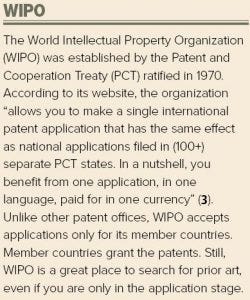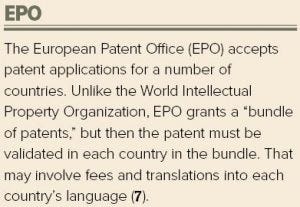Demystifying the Patent Search Process — Revisited
September 21, 2019

Photo Credit: https://pixabay.com
One of the first steps toward understanding how to patent an invention, invalidate someone else’s, or enter a new area of research is conducting a patent search. Knowing whether your invention is similar to those that already have been reported is critical before applying for a patent or beginning research. If your invention has been patented already or has been described or published anywhere in the world, then it is considered “prior art,” and your patent will be denied. Numerous patents granted in your research area can limit the scope of your research field.
Here I revise my original 2003 article on patent searching (1) and discuss fundamental principles regarding patents that you should know before starting your patent search. I also suggest some searching principles and list databases (both fee-based and free) that can be used to search for “prior art.”
Patent Basics
One of the basic tenets of intellectual property law is that patents are granted to advance innovation by encouraging inventors to publish their inventions. Inventors are given exclusive rights to prevent others from making, using, selling, offering to sell, or importing their invention for a set period of time — generally 20 years from the time an application is filed. That incentivizes inventors to publish (as patents) their inventions and advance the state of the art, giving everyone a new “plateau” on which to build.
Certain criteria must be met to patent an invention. The invention must be
nonobvious
novel (previously undiscovered)
useful (have practical use)
categorized by law or statute as patentable.
 Sources for information about fundamental patent principles include the US Patent and Trademark Office (USPTO) (2) and the World Intellectual Property Organization (WIPO) (3).
Sources for information about fundamental patent principles include the US Patent and Trademark Office (USPTO) (2) and the World Intellectual Property Organization (WIPO) (3).
Numerous laws and cases describe what innovations are patentable. For example, isolated, naturally occurring genes are not patentable because they have been ruled “products of nature.” However, complementary-DNA (c-DNA), which is produced synthetically by messenger RNA, is patentable (4).
How different does an invention have to be to be patentable? The answer depends on the specific invention and on the advice provided by a patent attorney. In the United States, Japan, and WIPO’s jurisdictions, the individual country’s patent office makes this determination. But in general, suppose an invention is patented. Later, an application is made for a new invention that is similar to the patented invention but has an additional feature or part (an extension). That new extension must be nonobvious to someone skilled in the field of the invention. In other words, if an improvement in the latter patent would be obvious to a person who is skilled in that field, then that improvement is not patentable.
Again, patent offices have their own laws, protocols, and procedures to help patent officials make final judgments.
Search Principles
Three basic types of patent searches are familiar to those in the patent information field: a validity search, a freedom-to-operate search, and a patentability search.
A validity search is meant to invalidate a patent by finding prior art (previously published information describing the invention). Typically, several good examples of prior art are taken to a patent attorney for evaluation.
A freedom-to-operate search requires an inventor to scan the entire published landscape and determine whether many or few patents and publications exist in a research field of interest. If many are found, then an inventor might need to adjust his or her strategy accordingly, either by selecting a new field of research or moving forward with the knowledge that the work will be carried out in a saturated field. Ideally for this type of patent search, everything published anywhere and anytime must be searched. In practice, an experienced searcher usually applies due diligence to search specialized, commercial databases (along with other sources) to conduct a search.
A patentability search is performed to determine whether a specific invention can be patented. It is similar to a freedom-to-operate search in that, ideally, all literature ever published should be searched. Because that is impossible in practice, professional searchers use their judgment. Remember, it isn’t just patent literature that can stop you from patenting an invention. If an invention is known in prior art (e.g., patents, journal articles, internets, posters, presentations, drawings, blueprints, descriptions), your invention cannot be patented.
 If you’re going to conduct a validity search, use sources from patent offices such as the USPTO, WIPO, Japan Patent Office (JPO) (5), and the European Patent Office (EPO) (6). Search any other sources you can think of that are available to you.
If you’re going to conduct a validity search, use sources from patent offices such as the USPTO, WIPO, Japan Patent Office (JPO) (5), and the European Patent Office (EPO) (6). Search any other sources you can think of that are available to you.
You might not want to search all patent country offices because that will take a great amount of time, and WIPO and EPO cover multiple countries already. A loose rule of thumb is to “follow the money”: Patent applications are likely to be filed in countries with the highest profit potential. That would entail filing with the USPTO, JPO, EPO, and WIPO. If you search those and find nothing, then you should consult with a licensed intellectual property attorney and/or patent searcher to have a more thorough search conducted. It’s hard to prove a negative.
Innovators often invest time and resources to protect their inventions in more than one country or jurisdiction. That requires filing essentially the same application with different patent offices. Doing so creates patent families, in which the same invention has multiple patents (with different patent numbers) from different countries.
Conducting patentability and freedom-to-operate searches provides a rough picture of the landscape surrounding an invention. However, for legitimate and complete searches of these last two types, a professional searcher is recommended.
Searching Techniques If you are doing the search for yourself, you are likely to know the field and the purpose of the search. But if you are searching on behalf of someone else, you should do the following:
If you are doing the search for yourself, you are likely to know the field and the purpose of the search. But if you are searching on behalf of someone else, you should do the following:
Find out as much as you can about the objective of the search. Ask the person you are working for a lot of questions.
Work hard to understand the invention and associated technology.
Choose the best, most appropriate database in which to search.
Regarding search techniques, my advice is use every search engine and interface at your disposal and experiment thoroughly. You also should search through YouTube videos (those from academic librarians are recommended) to find instructions on common database search techniques. Search the YouTube site with keywords such as “database search techniques” for videos about search principles and techniques (e.g., Boolean operators, phrase searching, field searching, truncation). If there is a function to clear the search page, make sure you use that between every search you run so that old information from a previous search does not hang around and hurt your next one. That solves a common problem for beginners.
Each database search page is different, and there may be different ways to search within a single database. However, some searching techniques and principles are common across databases although the look of the database interfaces may differ.
Novice searchers also might use classification-code searching. The International Patent Classification (IPC) System article at Espacenet Patent Search, EPO, provides more information about this powerful search method (9).
Databases and Literature
Free, regional patent databases include
Espacenet (https://worldwide.espacenet.com), EPO
US PatFT for patents and AppFT for applications (http://patft.uspto.gov), USPTO
J-PlatPat (https://www.j-platpat.inpit.go.jp/web/all/top/BTmTopEnglishPage), JPO
The EPO site contains helpful information on searching Japanese patents (https://www.epo.org/searching-for-patents/helpful-resources/asian/japan/search.html). Searching Japanese patents can be daunting if you don’t learn the nuances of the Japanese patent system. Those patents are machine-translated into English. Although the translations are not guaranteed to be accurate, they do provide a good idea of a patents’ contents.
Other free databases to search include
Google Patents site and the “About Google Patents” page provide information on searching, English translation of patents in the database, and information on technical papers and books.
Freepatentsonline.com (for patents with US, European, WIPO, and JP numbers) allows you to save searches. Some databases also provide alerts, which will send emails automatically when a patent is filed in your area of interest.
Patentscope (WIPO) has a chemical structure and substructure search, with a user’s guide (10).
Commercial databases can be expensive and thus prohibitive for individual inventors, but often they are the most-complete, highest-quality resources available. Professional searchers and large companies can afford the subscription costs as part of doing business. Some commercial databases also might be available at libraries.
Other biotechnology databases also are useful. A wiki published by the Patent Information User Group (PIUG) lists about 16 of these databases, half of which are free, but some of the better ones are not (11). The PIUG is a group of individual searchers and others interested in intellectual property information. Some useful information can be found on the PIUG site and wiki, including a long list of patent information databases. Another biotechnology database is GenBank from the National Institutes of Health (NIH). It is a genetic sequence database that contains an annotated collection of all publicly available DNA sequences (12)
Literature: The following are examples of general literature resources (not necessarily patent databases) provided here for illustration purposes. Literally hundreds of these resources are available. To find more, you could start your search by typing “free databases in [your subject].”
PubMed, a huge US government biomedical database
Directory of Open Access Journals (DOAJ), a huge database of open-access (free subscription) journals, many of which are full-text searchable.
Google Scholar for scholarly articles, books, and reports — many in full-text
BioMedCentral, more than 300 open-access journals in science, technology, engineering, and medicine.
IngentaConnect, a free search of over 20,000 journals (free title and abstract, charges apply for a full article).
Keep Searching
For questions regarding what can and cannot be done for a specific project, consult a patent attorney and/or professional patent searcher. If you don’t find the information you need, that doesn’t mean it’s not there. You may not have all the tools you need to find what you are looking for.
A lot of information is provided free. Conducting a patent search (or having one performed) can play a critical role in your decision whether to patent an invention or to start a new field of research. If your aptitudes and interests align with this type of work, it also can be a fascinating and rewarding profession. Get on the databases. Don’t let them intimidate you. Experiment when learning how to search through them.
References
1 Ward RK, Ikeler B. Demystifying the Patent Search Process. BioProcess Int. 1(8) 2003: 26–28.
2 General Information Concerning Patents. United States Patent and Trademark Office (USPTO): Alexandria, VA, Oct. 2015; https://www.uspto.gov/patents-getting-started/general-information-concerning-patents.
3 Frequently Asked Questions: Patents. World Intellectual Property Organization (WIPO); https://www.wipo.int/patents/en/faq_patents.html.
4 Can Genes Be Patented? Genetics Home Reference, US National Library of Medicine: Bethesda, MD, 6 Aug. 2019.
5 Searching for Patents, Utility Models, Designs, Trademarks. Japan Patent Office (JPO); https://www.jpo.go.jp/e/faq/yokuaru/searching.html.
6 Searching for Patents. European Patent Office (EPO); https://www.epo.org/searching-for-patents.html.
7 How to Apply for a European Patent. European Patent Office; https://www.epo.org/applying/basics.html.
8 Budapest Treaty on the International Recognition of the Deposit of Microorganisms for the Purposes of Patent Procedure. World Intellectual Property Organization: Geneva, Switzerland.
9 International Patent Classification (IPC) System, Escapenet; https://worldwide.espacenet.com/help?locale=en_EP&method=handleHelpTopic&topic=ipc.
10 Chemical Structure Search. World Intellectual Property Organization 13 Oct. 2016; https://www.wipo.int/patentscope/en/news/pctdb/2016/news_0008.html.
11 Patent Databases. Patent Information Users Group, Inc.: Newark, DE, 7 Dec. 2017
12 GenBank Overview. National Center for Biotechnology Information, 28 March 2019; https://www.ncbi.nlm.nih.gov/genbank.
Randall K. Ward is a former professional patent searcher and retired chemist and librarian; [email protected].
This article is for informational purposes only and may not be relied on as legal advice. No warranty is given as to the suitability, sufficiency, or applicability of the information in the article. If you have rights you are seeking to protect under patent laws or other intellectual property laws or if you have other legal concerns, you should seek the advice of a licensed attorney and should not rely on the information in this article.
You May Also Like





